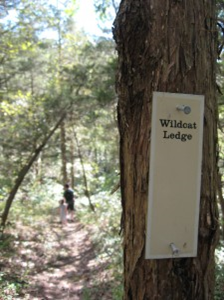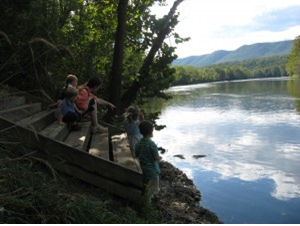by Alecia Rolling, original writing posted on September 9th, 2012 at www.therollingacresfarm.com
 After Mass today, we enjoyed a lovely afternoon hiking in the Shenandoah River State Park. We hiked on two trails. First, the Cottonwood Trail is rated as an easy trail, and most of the trail is a boardwalk. This would be a great choice if you planned to use a stroller. Second, at the end of Cottonwood was Wildcat Ledge Trail, rated difficult. It is only .2 mile, so we thought everyone could handle it. A steep climb to the top, then a beautiful view! The only child who gave up was #3 (2 years old). These two trails together were just right for all of us: Papa, Mama, 5 year old, 3 year old, 2 year old, and 1 year old. Of course the 1 year old did not hike, but rode on Mama’s back.
After Mass today, we enjoyed a lovely afternoon hiking in the Shenandoah River State Park. We hiked on two trails. First, the Cottonwood Trail is rated as an easy trail, and most of the trail is a boardwalk. This would be a great choice if you planned to use a stroller. Second, at the end of Cottonwood was Wildcat Ledge Trail, rated difficult. It is only .2 mile, so we thought everyone could handle it. A steep climb to the top, then a beautiful view! The only child who gave up was #3 (2 years old). These two trails together were just right for all of us: Papa, Mama, 5 year old, 3 year old, 2 year old, and 1 year old. Of course the 1 year old did not hike, but rode on Mama’s back.
While hiking, the kids and I looked closely at many things. #2 was interested in finding acorns and walnuts. When we came upon a broken walnut shell, we talked about what kind of animals may have opened the nut. When we found a half-chewed acorn, we again tried to guess the animal that bit it. Bear? Squirrel? Deer? Raccoon? This was fun! On top of Wildcat Ledge we found trees growing out of the rock. Moss and Lichen was also of plenty. These will be great fodder for minds that discern between living and non-living things this week.
After hiking, we went down to the water’s edge to relax a bit before returning home. Here we found quite the spider! A Mama spid er who was protecting all her baby spiders. This was a great up-close encounter for the children who are about to spend a year on Animal Life for science. Tomorrow in home school we must read about spiders and their young in our Seaside and Wayside Nature Reader!
er who was protecting all her baby spiders. This was a great up-close encounter for the children who are about to spend a year on Animal Life for science. Tomorrow in home school we must read about spiders and their young in our Seaside and Wayside Nature Reader!
Connecting the Dots: The Schola Rosa Curriculum combines real outdoors experiences with science lessons both in the classroom and outside. This “grounded” experience gives the child the solid foundation he or she will need when learning more difficult concepts of science later in life.In other words, if you wish to teach a child about erosion, then it helps if the child has actually seen dirt being carried away by a rivulet during a rain shower.
